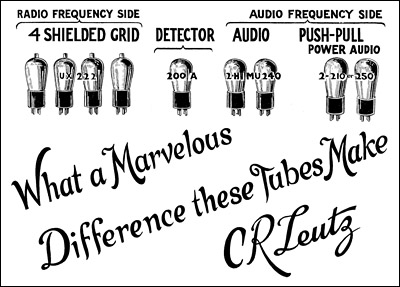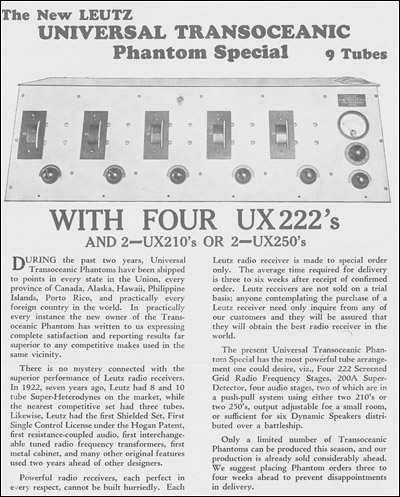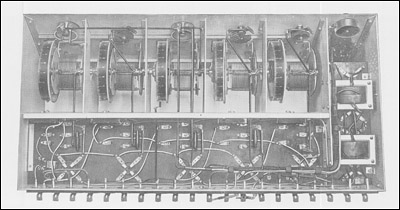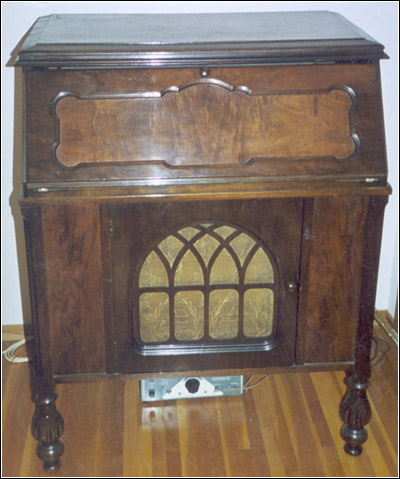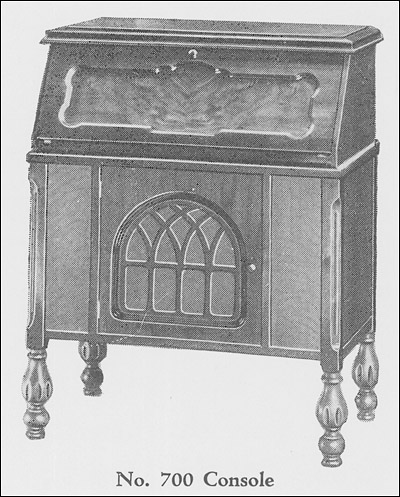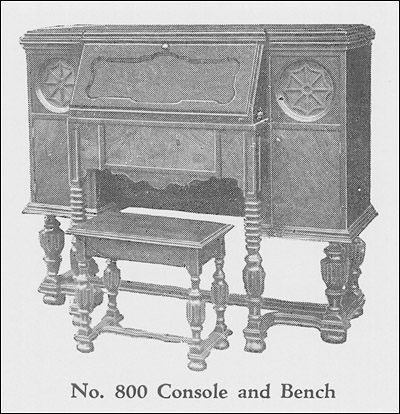Of Old Radios And Related Items--Published Monthly
More on the Leutz Universal Transoceanic
Phantom Special Type 9BY DANIEL SCHOO
Web Edition
The Leutz Universal Transoceanic Phantom seems to be an inexhaustible subject of interest. New information has surfaced, and, luckily, Dan Schoo is always willing to share it. The set in this article is the same set as in the previous two articles. The full name is "Phantom Special Type 9." (Editor)
Following the publication of my restoration article on the Leutz Universal Transoceanic Phantom Special Type 9 in the October 2007 issue of Antique Radio Classified, I received a letter with some photographs from another Phantom owner. This information allowed me to compare notes and verify a few details, resulting in a follow-up article which appeared in the June 2008 A.R.C. Well, here I am again with some more recently acquired details.
Several weeks ago I received from Jay Thomas, another A.R.C. reader, an original 1929 C.R. Leutz advertising circular once sent to dealers. The circular was in the form of a double-sided poster 22" wide by 17" high, and it referred to the C.R. Leutz, Long Island City, New York, address. I was delighted to get this particular document because it had vital bits of information that I had not seen anywhere else.
Figure 1. Promotion for the Leutz Universal Transoceanic Phantom Special featuring the tube functions.There were several lingering questions that I had sought to answer when I wrote the original article. As many of you know, tracking down trivia about a radio manufacturer from over eighty years ago is based on a lot of hard work, a lot of luck, and sometimes the generosity of other collectors. If verifiable information is unavailable, it is necessary to make a few experienced guesses and present the information as such.
Some Errors and Previous Assumptions
With this Leutz circular I can verify some of my previous assumptions, correct a few others, and add to the details about pricing and options. One blatant error that I would like to correct is my assertion that the UX-222 screen grid (tetrode) tube was the only 4-pin tube with a top cap. I should have known better, having forgotten about the RCA Types 32 tetrode and 34 pentode, both of which are battery tubes with a 4-pin UX base and a top cap.
The tube lineup in most of the Phantom advertisements that I had found highlighted the fact that UX-222 screen-grid tubes were used for the radio frequency amplifiers. At the time of its release in October of 1927, the UX-222 screen grid tube was a breakthrough development and far superior to the traditional UX-201A triode. The UX-222 had the ability to provide much more gain than a UX-201A simply because the addition of a second grid made the tube a lot more stable in radio frequency circuits. It was thereby able to amplify the signal to a much higher degree without oscillating.
Figure 2. Promotion for the Leutz Universal Transoceanic Phantom Special from the circular.Other tubes often mentioned in Leutz ads were the UX-200A detector and either a Type UX-210 or UX-250 used as push-pull audio outputs. However, there was no mention of the two audio preamp tubes.
I had assumed that the two audio preamp tubes were the usual UX-201A types that everybody used at that time. Actually, the audio preamp tubes in the Phantom were Type UX-240 voltage amplifier triodes that RCA had announced in February of 1927. They were pretty much the same as a UX-201A, but they had almost four times higher voltage gain. In this particular application, they were not necessarily any better than a UX-201A. In the operational tests I had performed on the Phantom, I found that UX-201A tubes worked perfectly well.
Figure 3. "The photographic reproduction here of the interior of the Shielded Grid Tube Set gives you an idea of the delicacy, yet sturdiness of its construction. Leutz Receivers are built like watches, yet wear like locomotives." (From the Leutz circular)
Figure 5. On the top is Russ Mason's Phantom No. 700 Console Complete from Daniel Schoo's June 2008 article. On the bottom is the No. 700 Console Complete as advertised in the circular. The wholesale price for the complete set was $388.20 net, and the list price was $647.Another assumption that I had made was that I could change the frequency coverage by changing the TRF interstage coils with other coils wound for a different frequency. The coils supplied with the Phantom were marked "A" on the bottom along with the number of the stage that the coil was intended to be plugged into. The Leutz ad specifies the Type A coils as having a wavelength range of 200 to 560 meters or 1500 KHz to 536 KHz. This range is almost exactly what I had measured in the operational tests.
Other coils were available for the short and long-wave bands for an extra charge. Regrettably no specific information is given on what other frequencies could be tuned using these coils.
Power Supply Details
The Phantom was designed primarily to operate completely from AC power for "A" (filament), "B" (plate), and "C" (grid bias) voltages. While it could be operated from batteries, it would have been very inconvenient.
The AC filament current for the audio output tubes and the various plate, screen, and control grid bias voltages were provided by a separately available Leutz BC power supply. The BC supply used two Type 81 rectifier tubes and a resistor divider to provide the various operating voltages necessary for the operation of the Phantom. It also had AC receptacles on the back for a separate A battery charger or A battery eliminator. Power switching in the BC supply controlled both the B and C power supplies and also switched an A filament battery, an A battery charger or an A battery eliminator, whichever was used.
A 6-volt storage battery could be used as the A supply to power the DC-operated filaments of other than the audio output tubes. Preferably, a Leutz A supply, also available separately, was used to power the filaments for full AC line-powered operation. The Leutz A supply used a "dry type" rectifier, such as a copper oxide stack. Plugging the A supply into the special AC socket on the Leutz BC supply switched it on and off with the rest of the power to the set.
More General Leutz Details
Back in the early radio days, long distance reception was the big selling point. Radio stations were generally not as powerful as they are today, and long distance reception depended on sensitivity. Leutz boasted a five to seven-day air test of every Phantom to receive stations as far away as 2,500 to 3,000 miles before it was shipped. The company claimed that one of its receivers in Los Angeles received stations spanning from Brisbane, Australia, to Pittsburgh. Another set located in Guayaquil, Ecuador, received stations ranging from Rio de Janeiro to New York.
Another interesting note was that in addition to the basic satin aluminum finish, the Phantom, along with an associated BC power supply, could be finished with an imitation mahogany, walnut, or marble at no additional charge. American walnut was reported to be the most popular finish.
Rounding out the package, a number of other optional accessories were available, including walnut cabinets. Russ Mason's Phantom, shown on page 16 of the June 2008 issue of A.R.C., is one such package of accessories. That particular model was called the No. 700 Console Complete and included the Phantom, a BC power supply, an A supply, a set of tubes, a dynamic speaker mounted in the console, and the console itself. See Figure 5 for both Russ's set and the set as advertised in the circular.
Figure 6. The No. 800 Console Complete included the Phantom Special, A, B, and C power supplies, tubes, a speaker mounted in the console, and a bench. The complete package sold for $448.20 wholesale and $747.00 list.For the ultimate, the No. 800 Console Complete, shown in Figure 6, was also available. It included all of the No. 700 electronic components, plus a larger, much more ornate cabinet with a bench seat. In addition, the No. 800 could be ordered with an AC-operated record player mounted in the cabinet for an additional charge.
For a less expensive setup, the No. 500 dynamic speaker cabinet highboy accessory provided an enclosure for the user to mount a dynamic speaker and to have a tabletop to hold the Phantom. The No. 500 was also available in package form with all of the standard electronics, including a dynamic speaker.
The Advertising Circular
Intended for dealers, this Leutz advertising circular includes both list and wholesale prices. Factory orders were accepted on a cash basis with full payment expected up front. Alternatively, they would accept a 25 percent deposit with the balance to be paid by cash on delivery. Each Phantom was guaranteed to be free of electrical or mechanical defects for one year.
This advertising circular illustrates the high-end marketing of the Leutz Phantom and accessories. Very impressive prices and typical glowing descriptions showcase the Phantom. One wonders how long the pricey Phantom lasted after the stock market crash of 1929 -- especially in light of the rapid advances in radio design and the introduction of compact low-priced superheterodyne sets of the early 1930s. These sets challenged the old TRF sets quite well in performance and devastated them in ease of operation.
Special thanks to Jay Thomas for supplying the Leutz sales circular which is the basis of this article.
References:
C.R. Leutz sales circular, 1929, inclusive.
Tyne, Gerald. F.J. Saga of the Vacuum Tube. Tempe, AZ: Antique Electronic Supply, 1977, pp. 317-318.
© October 2008 Daniel Schoo
Daniel Schoo, a frequent subscriber to A.R.C., is an electronics design engineer with a lifetime interest in antique technology, especially radio and television equipment. In addition to his collection of 1930s and 1940s radios and video cassette recorders, he has a large collection of vintage vacuum tubes, neon lamps, and tube data books.
|
[Free Sample] [Books, etc., For Sale] [Subscribe to A.R.C./Renew] [Classified Ads] [Auction Prices] [Event Calendar] [Links] [Home] [Issue Archives] [Book Reviews] [Subscription Information] [A.R.C. FAQ]URL = http://www.antiqueradio.com/Jan09_Schoo_SpecialType9.html Copyright © 1996-2008 by John V. Terrey - For personal use only. Last revised: December 30, 2008. For Customer Assistance please contact ARC@antiqueradio.com or call (866) 371-0512 toll free Pages designed/maintained by Wayward Fluffy Publications Antique Radio Classified |
